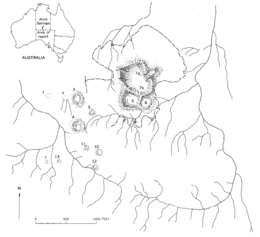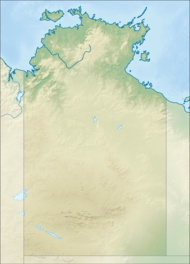|
Henbury Meteorites Conservation Reserve
Henbury Meteorites Conservation Reserve is a protected area in the Northern Territory of Australia located in the locality of Ghan.[1] Henbury craters are a result of one of the few impact events that have occurred in a populated area (few other examples are Kaali crater in Estonia and 2007 Carancas impact event in Peru). DescriptionThe reserve is located 125 km (78 mi) south west of Alice Springs and contains over a dozen craters, which were formed when a fragmented meteorite hit the Earth’s surface.[citation needed] Henbury is one of five meteorite impact sites in Australia with remaining meteorite fragments and one of the world's best preserved examples of a small crater field.[3][4] Henbury was the earliest documented example of impact cratering in Australia.[5] Meteorite impact craters
At Henbury there are 13 to 14 craters ranging from 7 to 180 m (23 to 591 ft) in diameter and up to 15 m (49 ft) in depth that were formed when the meteor broke up before impact. Several tonnes of iron-nickel fragments have been recovered from the site. The site has been dated to ≤4.7 thousand years ago based on the cosmogenic 14C terrestrial age of the meteorite[6] and 4.2±1.9 thousand years ago using fission track dating.[7] The craters are named for Henbury Station, a nearby cattle station named in 1875 for the family home of its founders at Henbury in Dorset, England. The craters were discovered in 1899 by the manager of the station, then went uninvestigated until interest was stirred when the Karoonda meteorite fell on South Australia in 1930.[8] The first scientific investigations of the site were conducted by A.R. Alderman of the University of Adelaide who published the results in a 1932 paper entitled The Meteorite Craters at Henbury Central Australia.[9] Numerous studies have been undertaken since. Cultural significance The Henbury crater field lies at the crossroads of several Aboriginal language groups, including Arrernte, Luritja, Pitjantjatjarra, and Yankunytjatjara. It is considered a sacred site to the Arrernte people and would have formed during human habitation of the area.[10] J.M. Mitchell[11] said that older Aboriginal people would not camp within a couple of miles of the Henbury craters. An elder Aboriginal man who accompanied Mitchell to the site explained that Aboriginal people would not drink rainwater that collected in the craters, fearing the "fire-devil" would fill them with a piece of iron. The man claimed his paternal grandfather had seen the fire-devil and that he came from the Sun. An Aboriginal contact said of the crater field: tjintu waru tjinka yapu tjinka kurdaitcha kuka, which roughly translates in the Luritja language as "A fiery devil ran down from the Sun and made his home in the Earth. He will burn and eat any bad blackfellows." This indicates a living memory of the event.[12] A different story was recorded by Charles Mountford [13] that attributed the largest crater's formation to an anthropomorphic lizard woman (called Mulumura) tossing soil out of the crater, forming its bowl-shape. The soil discarded by Mulumura explained the piles of meteoritic iron around the craters and the presence of ejecta rays (which are unique to terrestrial impacts but are now gone due to prospecting at the site).[14] This probably relates to Dreaming stories about ancestral lizard beings from the area of Henbury station near the Finke River, just north of the crater field. The Parks and Wildlife Commission of the Northern Territory give the Arrernte name for the crater field as Tatyeye Kepmwere (or Tatjakapara). In 1980, the conservation reserve was listed on the now-defunct Register of the National Estate.[15] The craters were listed as one item on the Northern Territory Heritage Register on 13 August 2003.[16] See also
References
Literature
External links |
||||||||||||||||||||||||||||||||||||





